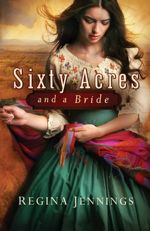Regina Jennings’ debut novel,
Sixty Acres and a Bride (Bethany House), is making
its mark as a shining addition to the historical romance genre. Full of imaginative plotting and
a sweet and tender realism that is sure to capture readers’ hearts, the inspiration for this romance novel came from a rather uncommon source…
1. Where did your inspiration for Sixty Acres and A Bride come from?
I was writing a Ruth and Boaz skit for a church production and had big plans for it—secondary
characters, subplots, and a love story that didn’t get ironed out until they’d been married for a
spell. Right as the dialogue started to jell I found out that the skit could only be fifteen minutes
long. Bummer. By then I couldn’t let go of these characters until I’d heard their story.
2. What led you to explore the Ruth and Boaz story, in particular?
Oddly enough, the Ruth and Boaz skit I wrote was for our church Christmas play. The theme
was Redeemer and we needed skits that demonstrated the idea of redemption. Being a Christmas
play, it included the mandatory nativity scene complete with cheesy Bethlehem costumes. The
last thing I wanted was to subject our volunteer cast to another drama in bathrobes, so I tried
to think of costumes we could acquire without much effort. In Oklahoma almost everyone has
cowboy boots and seeing how the whole story revolves around Ruth and Naomi’s efforts to save
the farm, it was a natural fit.
3. What is the most challenging part about writing for you?
I could name all four of my challenges and in fact I did name them when they were born. Our
kids stay home for their schooling, so—like the Lord—they are always with me. Usually I have my
laptop open during the school day and tap out a few rough paragraphs while supervising their
work, but polished writing rarely results. After lessons are finished we load up for basketball or
band practice where I hide in a corner and try to scratch out a few more paragraphs before we
head home for dinner. Most of my usable work comes from my evening writing sessions when
Pa Jennings takes charge of the troops. In many ways, my situation is no different than other
writers who have full-time jobs, with the benefit that I’ve already done my Mommy time during
the day.
4. Did writing Sixty Acres and A Bride involve any special research?
I spent a lot of time researching the Chisholm Trail and cattle drives, and then included almost
none of that information in the final draft. Oh well. If I’m ever on Jeopardy and the Chisholm
Trail comes up as a category, it’s money in the bank.
Another area that garnered extra research was the Nahua/Aztec culture. For Rosa to truly feel
like an outsider in Texas, she needed to be from a people group that had retained their pre-Colombian customs. We tend to think of Mexico as a homogeneous culture, but like the U.S. it
has been influenced by many great civilizations, both native and imported.
And since Sixty Acres takes place in an actual location, I traveled to Caldwell County to look
around, make new friends and enjoy some fantastic Bar-B-Q and banana pudding. When
writing about 19th Century Texas it’s difficult to accurately describe a culture that included both
tough cattlemen and their Victorian ladies, but seeing the beautiful architecture—the library, the
bank, the courthouse—and then seeing the cattle trailers still parked around the square, helped
me find the balance.
5. Why do you think it is important to be writing romance novels?
May I never see the day when romance is irrelevant. Don’t we all want to be cherished by
someone worthy of our regard? Don’t we want to be set apart for someone special? God
invented romance, and is our perfect Hero. He’s the Knight on the white steed coming to rescue
his bride from the enemy. I feel strongly that Christians mustn’t delegate the telling of love
stories to unbelievers. It’s our birthright. Love is our message.


